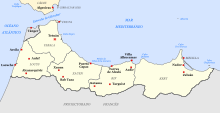- Army of Africa (Spain)
-
The Army of Africa (Spanish: Ejército de África or Cuerpo de Ejército Marroquí, "Moroccan Army Corps" Arabic: الجيش الإسباني في أفريقيا) was a Spanish field army that garrisoned Spanish Morocco from the early 20th century until Morocco's independence in 1956.
At the start of the 20th century, Spain's colonial possessions in Africa comprised Spanish Morocco, Western Sahara, Ifni, Cabo Juby and Equatorial Guinea.
Contents
Spanish Morocco
Spanish Morocco was the closest Spanish colonial territory to mainland Spain and the most difficult to control. A major Moroccan revolt against both Spanish and French colonial rule took place in 1919, beginning with the destruction of a Spanish army at Annual. The Rif tribes were finally subdued only with difficulty by substantial Franco-Spanish forces after several years fighting.
Role in the Spanish Civil War
The Army of Africa was composed of Spanish troops as well as the Spanish Foreign Legion and locally recruited Moroccan infantry and cavalry called Regulares. In total, the Army of Africa numbered 30,000 soldiers and was the most professional and effective fighting force in the 100,000-man Spanish Army during the 1920s and 30s. Infantry recruited in the enclave of Ifni ("Tiradores de Ifni") were also considered part of the Army of Africa.
The Army of Africa was to play a key part during the Spanish Civil War of 1936–39. Along with other units in the Spanish Army, the Army of Africa rose against the Spanish Republican Government and took part in the Nacional military rebellion of July 1936. On July 18, 1936, General Francisco Franco assumed the supreme command over this force.
Spanish Morocco fell to the rebels without significant opposition. The initial intention was to transport the Army of Africa to mainland Spain by sea. However the crews of Spanish warships whose officers had joined the revolt remained loyal to the Republican government in Madrid. Significant numbers of the Army of Africa were accordingly transported to mainland Spain in a bold airlift led by Junkers and Savoia-Marchetti transport planes supplied by Germany and Italy.
After landing in Spain, the Army of Africa was split into two columns, one commanded by General Juan Yagüe and the other commanded by Colonel José Varela. Yagüe's force advanced north, making remarkably rapid gains, and then turned north-eastwards towards Madrid and Toledo. Varela's force entered Andalusia and took control of the key cities of Seville, Granada, and Cordova. Thanks mostly to the Army of Africa's advances, almost all of western Spain was in Francoist Nacionales hands by the end of September 1936. By early 1937 the Army of Africa's strength had been increased to 60,000 men. The Legion and Regulares spearheaded the Nacionales's operations for the remainder of the war and played a central role in the Nacional victory.
Post Moroccan independence
Following Moroccan independence in 1956 the bulk of the locally recruited Regulares were transferred to the new Royal Moroccan Army. The cities of Melilla and Ceuta and the lesser plazas de soberanía as well remained Spanish and are still garrisoned by Legion and Regulares units.
See also
- Spanish Legion
- Regulares
- Guardia Mora
References
- Beevor, Antony. The Spanish Civil War. New York: Penguin Books, 2001.
Categories:- Military history of Spain
- Spanish Army
- Rif Wars
- Military units and formations of Spain
- Spanish Africa
Wikimedia Foundation. 2010.

